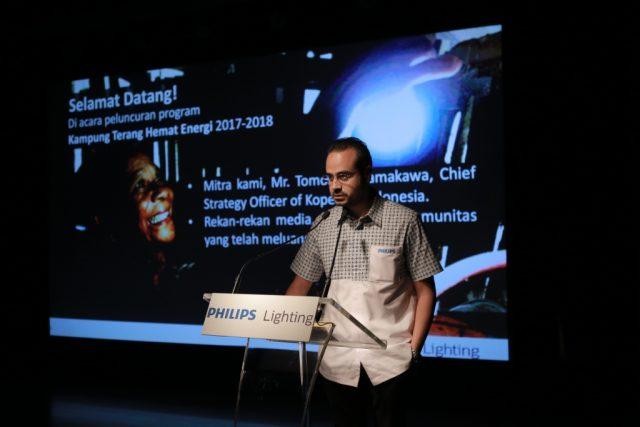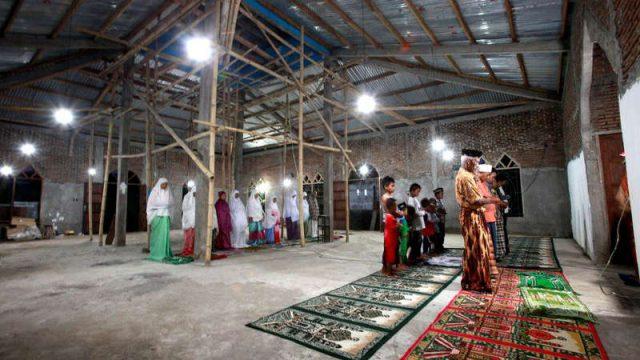The lighting infrastructure in Indonesia is reflective of a paradox. In Jakarta, for example, sky scrapers, residential buildings and high-end malls are equipped with advanced lighting systems which are both energy-efficient and come with smart and sophisticated features such as remote management.
More and more commercial high-rise buildings are lighting up, adding glitter to the beautiful city of Jakarta and its glimmering skyline. And yet, tens of millions Jakarta citizen take this gift powered by electricity for granted.
On the other hand, only a hundred kilometers from the Big J, some villagers in Garut, are still devoid of any electricity at all. They still rely almost entirely on candles and clay lamps to bring light to their lives, when the sun sets.
Considering Jakarta’s – or other major cities’ advanced lighting infrastructure – one might be tempted to think that’s all there is! But in fact, there are still about 12,659 villages in Indonesia where people are living without access to electricity.
According to another report, the percentage of households connected to the nation’s electricity grid was about 85% in 2015, indicating more that 40 million Indonesians are still living in the dark.
What do these number imply? For one, that electrification should be the government’s priority development program. Expanding electrification ratio will not only improve living standards of the people and bring them greater convenience but also create new growth opportunities for several businesses, including those of lighting manufacturers.
One such global lighting leader is Philips. For a company which was first set up business in Indonesia in 1942, there is still a vast untapped potential in terms of local lighting industries.
Several Indonesian cities are working towards achieving their smart city goals. Philips has also teamed up with many city governments to bring them closer to the digital age.
For example, Philips recently announced the Philips CityTouch project which involves upgrading nearly 9,000 connected street lights in Jakarta with energy efficient LED Lights. It represents a significant milestone in Jakarta’s ongoing transformation into a smart city.
To understand the bigger picture of Indonesia’s smart lighting market, Saviq Bachdar from Marketeers caught up with Rami Hajjar, the newly appointed Vice-President and General Manager, Philips Lighting Indonesia. Prior to this role, Rami had been working with Philips Lighting since 4 ½ years as General Manager Middle East for the company, overseeing operations in 13 different countries.
What’s the current state of lighting infrastructure in Indonesia across homes and villages?
Indonesia is definitely taking giant steps towards the establishment of what we call efficient lighting infrastructure, and offering good services for its citizens. We have, on one side, a great advancement when we look at Jakarta in terms of infrastructure. Most of the street lights in Jakarta today are smart lighting systems, highly energy-efficient and equipped with smart innovation.
Each light point is connected and performance data is sent through existing cellular networks to the city’s lighting office or operator. The data enables city officials to efficiently monitor the city’s lighting infrastructure and illumination levels to match the needs of each district.
On the other side, villagers know that the government today has a massive program to improve electricity access. The government seems committed to raising the electrification ratio and this means that demand for lighting should grow accordingly. We sincerely recognize the fact that there are so many Indonesians today who are still living in the dark.
What trends do you see emerging in the Indonesian market when it comes to smart lighting?
One thing we should all take pride in is the fact that Jakarta is recognized as a city which houses one of the biggest smart lighting installations globally. So this is something all Indonesians should be extremely proud of.
The government is taking steps towards providing such energy-efficient services, and not just by providing, but also saving a lot of energy as the number of people living in cities continue to grow. I am confident that Indonesia, through the support of its government, can indeed be a major contributor of smart lighting in the world.
As a private sector company which is involved in this industry since more than a hundred years ago, we have set up various projects in multiple cities across Indonesia, not only Jakarta, but other cities like Semarang.
In Central Java’s capital city, there are more than 50,000 street lighting points where manual maintenance is still required to find a faulty light. So we offer a technology solution that can be integrated with the system already in place.
It’s definitely a win-win solution for the citizens and the government. The government can benefit from energy conservation, provide smarter and faster services, at a reduced maintenance cost and effort. I believe it’s a great program that cities in Indonesia should get more and more interested in.
What is your vision of a smart city?
Smart city is a buzzword today but what does it really mean? For me, it’s simple. Smart city is a city that offers efficient services. A city which is sincerely and truly sensitized towards energy efficiency and takes the necessary steps towards that endeavor is a smart city. Jakarta is quite efficiency-focused, as a city hosting one of the biggest smart lighting infrastructures in the world.
This city moves rapidly. For example, instead of getting on to the road to check which light is working or which one is not, on a laptop we can have access to thousands and thousands of lights, so we know exactly what’s working and what’s not.
Smart city also means using less energy. They must use less energy in its infrastructure. And a smart city is a beautiful city when citizens enjoy living in the city. It’s all about creating a city’s identity. May be a simpler example is the fact that lighting has the power to make cities and landmarks beautiful.
The Eiffel Tower, for instance, is a steel structure. Without the dynamic lighting at night, would it stand out as much as it does today?
It implies to ‘Monumen Nasional’ and other wonderful landmarks in Jakarta. So, Jakarta with the proper lighting can become a more beautiful city that makes its citizens happier and makes their lives more enjoyable.
What is the main obstacle in educating people about smart lighting?
Like with every new technology, there is a certain level of awareness we need to bring in. It’s our responsibility to develop it. The technology specifically for lighting is moving quite swiftly.
We actually face a challenge to make sure all of the developments happening every few months are best-level innovations, because we invest a lot in Research & Development to bring the fastest possible way to our customers and partners.
It’s all about communication. It’s about making sure we have a relationship to ensure that the customer knows what we bring in. I see the technology and innovation of smart lighting is growing rapidly. That means people are open for it and welcoming it.
Please talk a bit about your initiative to light up rural Indonesia.
Despite Indonesia’s cities becoming more prosperous, it’s easy to forget that there are a whopping 120 million people living in rural areas who are yet to enjoy the same level of development. It’s no surprise, development is rarely homogenous.
Although electricity infrastructure has already penetrated most villages, electricity access is still considered a luxury for most low-income families which, out of necessity, remain off the grid. That’s why we come with the idea of Philips’ “Kampung Terang Hemat Energi” (Bright Energy-Saving Villages) as part of a government initiative to drive sustainable electrification in rural areas in the country.
We provide LED-Solar street lighting for rural villages. We are going to them from South Sulawesi, North Sumatera, East Bali, Central Borneo, to Maluku with more than 2,886 light points built so far. We know that one of the challenges that villages face is the fact that those are remote areas. We are leveraging every single transportation option that we can to approach them. The idea is to try to help the people who need it the most.
However, there are still many villagers in this country who need help in terms of electricity access. So we encourage others and everybody, also the private sector to be part of this initiative, to help as well, and to give back to communities.
When we are living in an environment, we have to give back to the environment. We just need to team up with more public and private sectors to make it faster, so more villages can light up, step by step.
Editor: Priyanka Sekhawat



